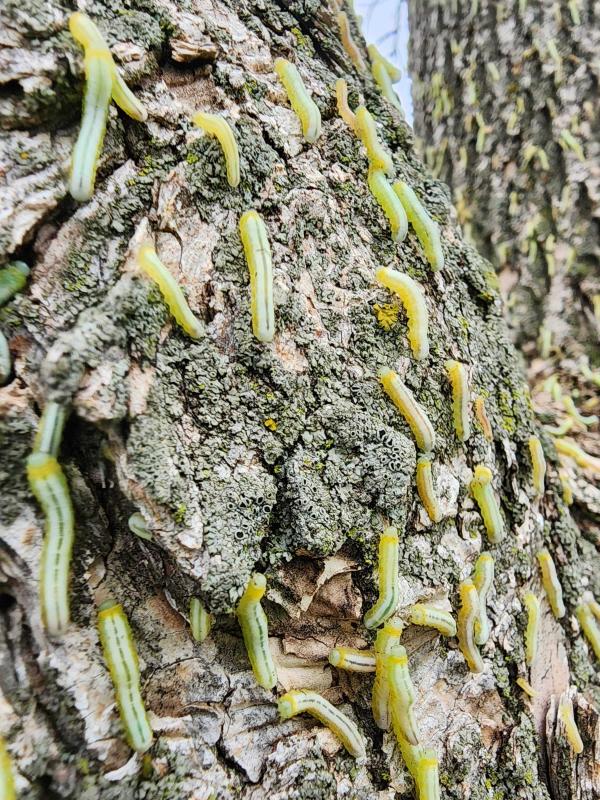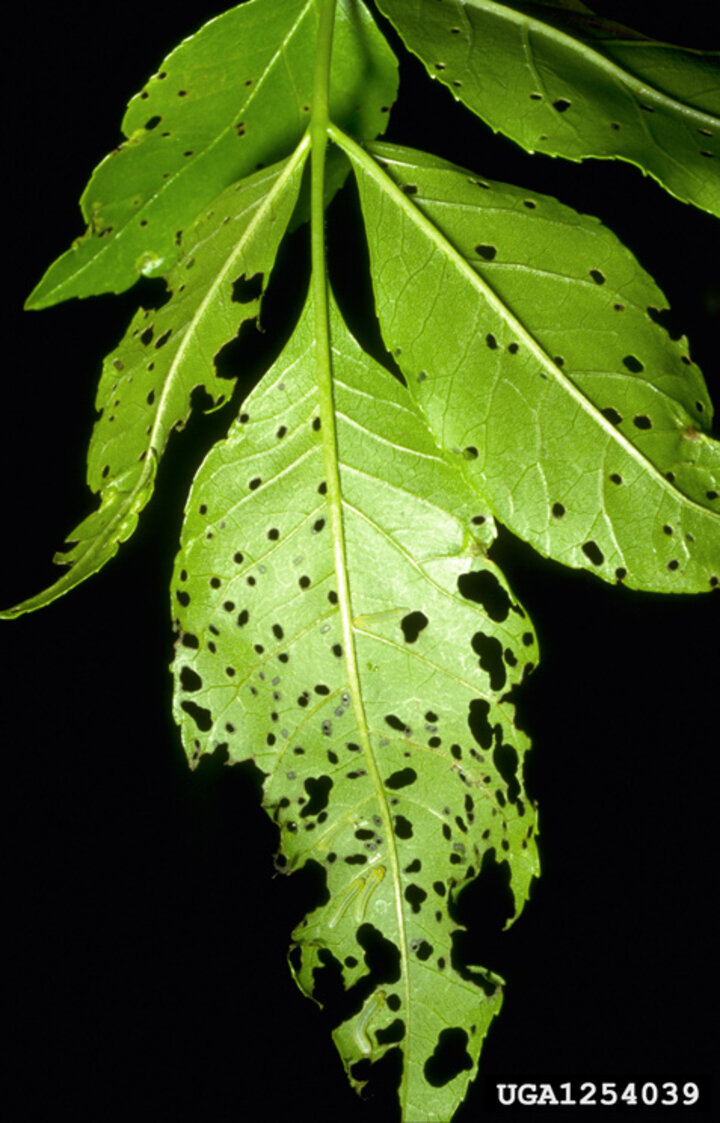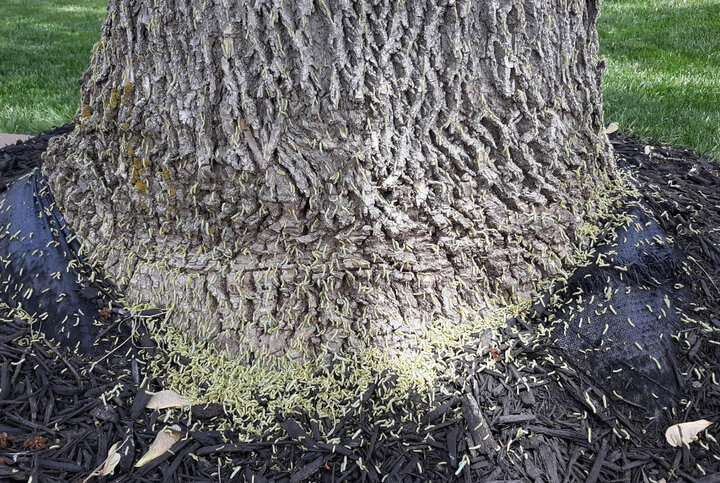Sarah Browning, Nebraska Extension Educator

Brownheaded ash sawfly larvae.
Dropping soon onto a patio near you – let me introduce the ash sawfly. Or maybe you’ve already been introduced to this insect; your Nebraska Extension office has been getting questions about this little greenish “songbird Snickers bar” all week!
Here’s the bottom line, this is ash sawfly and it isn’t going to kill your tree. Interested in a few more details?
What is a Sawfly?
Sawfly adults are very small, non-stinging wasps. They emerge in late April, mate and females begin inserting eggs on the edges of emerging leaves. These insects get their common name – sawfly – from the female’s ability to make small cuts in the leaf into which she inserts an egg.
Their larvae are caterpillar look-a-likes, but aren’t true caterpillars. There is only one generation of insects per year. Once the larvae become mature, they drop from the tree, move into the soil and create a protective cocoon where they will spend the next several months until the adults emerge the following spring.

In Nebraska, there are two species of ash sawfly.
- Brownheaded ash sawfly - can be found on all ash species, but green ash, Fraxinus pennsylvanica, is a favorite. Larvae are pale greenish-white, with a light tan head.
- Blackheaded ash sawfly – often found on white ash, F. americana, as well as green ash. Larvae are pale greenish-white with a black head.
Assessing the Damage

Initially, young larvae are small enough to feed inside leaves, between the upper and lower layers of leaf cells, producing small pinholes feeding wounds. As they get larger, they feed from the outside of the leaves, eating the tissue between leaf veins. With high insect numbers and at their peak of feeding, defoliation injury progresses quickly. But on the plus side, sawfly larvae only feed for a short time, usually 2-3 weeks from hatch to maturity.
Late spring freezes, those which often damage the earliest emerging ash leaves also kill many early adults and larvae. For that reason, sawflies are a sporadic pest appearing in high numbers infrequently – but unfortunately this is one of those years!
Healthy vigorous trees tolerate damage well and will continue to produce new foliage after the insects are gone. This new foliage will help compensate for any damaged foliage. Overall impacts to tree health are minimal - even with significant defoliation in bad years - when heavy infestations are infrequent.
Trees in poor health due to other stresses (drought, planting issues, borers, bark beetles, etc.) suffer more, especially with frequent infestations.
It’s also important to remember, sawfly larvae and other early season caterpillars are an important food source for songbirds feeding their young. That thought may make it easier for gardeners to tolerate sawfly damage, knowing their numbers this year are unusual and their presence will benefit songbirds.
Control
Spraying insecticide on large shade trees is very difficult, but fortunately it’s seldom warranted. Only young, low vigor, unhealthy or stressed trees should be considered for control, or healthy trees with more than 25% canopy defoliation. Larvae will be gone by early June making control efforts after that time a waste.

Gardeners often see large numbers of larvae falling from trees due to wind or rain – that’s good. Many of these insects won’t make it back up into the tree before being eaten by birds or a wide variety of other predatory insects. You can mimic Mother Nature and knock larvae out of a tree with a strong jet of water.
Ash sawfly larvae are easily controlled. Soapy water is effective when sprayed directly on the larvae. Most other common garden insecticides are also effective, such as carbaryl, permethrin, bifenthrin, spinosad. However, neem and Bacillus thuringiensis(BT, Dipel, Thuricide) will not provide control.
Other Common Landscape Sawflies
In addition to ash sawfly, there are a couple other sawflies that may be found in landscapes. As with ash sawfly, each has only one generation per year.
- Pine sawfly - There are several sawfly species which feed on pines and spruces as host plants, including European pine sawfly, which is common in Nebraska. Larvae hatch out from May to June and resemble a sage green caterpillar with a brown or black head. At first the larvae eat only the outer portion of needles, leaving behind the straw-like midveins. But as they mature and grow bigger, they consume whole needles. Larvae usually feed in groups and will rear back in a defensive posture when disturbed.
- Rose sawfly – Larvae hatch in early May and begin feeding on rose leaves, eating away plant tissue between the veins. As they grow, damage becomes more severe and leaves are skeletonized. Larvae are medium to light green with an orange head.
Use the same control techniques described above for ash sawfly.
Images:
- Brownheaded ash sawfly. Image by John Fech, Nebraska Extension
- Ash sawflies feed on leaves, causing defoliation. This is mid-season damage, mature sawflies completely remove leaf tissue between the veins resulting in skeletonization. Image by William M. Ciesla, Forest Health Management International, Bugwood.org.
- Sawfly larvae often fall out of the tree due to wind or rain. Many of these insects will be eaten by birds or predatory insects. Image by Bob Brousek, used with permission